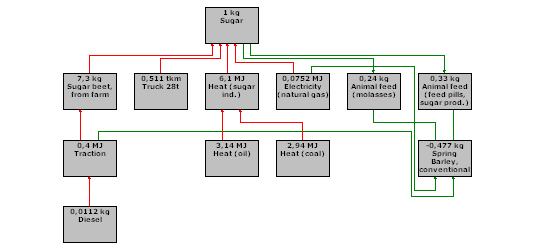European Union is a major exporter of sugar due to subsidies, import restrictions and special trade agreements (Walter-Jørgensen, 2001) and the extend of sugar production in Denmark is likely to be independent of the Danish market demand. Thus a marginal demand for sugar in Denmark will supposedly not influence processes in Danish sugar beet production and Danish sugar industry but rather the extend of sugar export to countries outside European Union. The extend of sugar export from Denmark influence the marginal sugar producer somewhere in the world. The location of the marginal sugar producer is unknown so far, but probably located in a developing country where sugar can be produced cheap from sugar cane. It has not been possible to find appropriate information about the marginal sugar production processes abroad and no data referring to the present market situation are available.
However, in order to provide data on Danish sugar production, a scenario has been envisioned where the public regulation of the sugar market is disregarded. Referring to this envisioned scenario, the main processes influenced by sugar demand are shown in the figure below, exemplified with sugar ex sugar factory.
|
|
| Figure 1: Market based product chain diagram on sugar production covering the most important processes in terms of contribution to global warming, provided that sugar production is regulated by market demand. Boxes refer to production processes. Names of grey boxes refer to the main product of the processes. Red arrows represent material or energy transfer between two processes; green arrows represent saved material or energy transfer as a result of displacements; green lines represent displacements and red lines represent avoided displacemements. Further details can be found in the LCA model. |
Sugar beets are produced in agriculture
and transported by truck to the sugar factory
where it is processed into sugar. Molasses and feed pills are co-generated
during sugar production and returned to agriculture as animal feed. It
is estimated (Landbrugets rådgivningscenter, 2000) that one kg molasses
displace 0.75 kg spring barley and that one kg feed pills displace 0.9
kg spring barley, explaining the green arrows to animal feed production
and and the green line to spring barley.
The table below shows potential environmental impacts associated with sugar demand ex factory and ex retail. All data are provided per kg of sugar.
| Impact category | Unit |
Sugar ex factory |
Sugar ex retail |
||
| Conventional | Organic | Conventional | Organic | ||
|
Global warming |
g CO2-eq. |
840 |
960 | ||
|
Acidification |
g SO2-eq. |
5.5 |
6.0 | ||
| Nutrient enrichment | g NO3-eq. | -12.8 | -12.1 | ||
| Photochemical smog | g ethene eq. | 0.73 | 0.83 | ||
| Land use | m2 year | 0.45 | 0.45 | ||
| Location in database: Material/Food from industry/From other industries/Sugar and Material/Food from supermarket/Others/Sugar in supermarket |
References
Walter-Jørgensen A, Grinsted Jensen H, Elkjær Frandsen S (20001). Reform af EU’s sukkerpolitik - Konsekvenser for EU og udviklingslandene (in Danish). Statens Jordbrugs- og Fiskeriøkonomiske Institut. Rapport nr. 126
Landbrugets rådgivningscenter (2000). Tal fra Fodermiddeltabellen, Raport nr. 91. In Danish.
